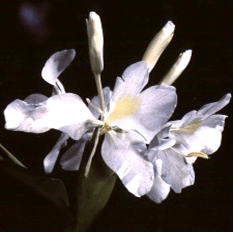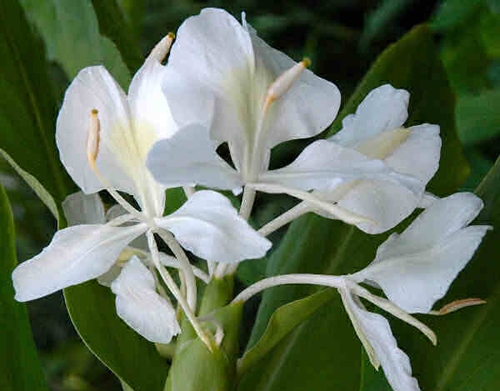

Description
Ginger lily, Hedychium coronarium (Gulbakawali or Kapur-Kachri), is a native to tropical and semi-tropical areas of Asia and Himalayas. Ginger lily is considered an invasive weed in Brazil. It was brought to the country by African slaves during the slavery era there. It is also known as the National Flower of Cuba 'Flor de Mariposa' or butterfly flower because it looks like a flying white butterfly.
Highly fragrant, women during Spanish colonization carried these flower on their person, allowing them to hide secret messages. It makes a beautiful background plant.
Ginger lily also is grown in mild winter temperate regions of North America and Europe where it dies back in winter but re-emerges in spring.
White butterfly ginger lily, or simply ginger lily, is a tropical perennial and a cousin of culinary ginger (Zingiber officinale) but it is not ediable. Its green stalks grow from thick rhizomes to a height of 1- 2. m. Leaves are lance-shaped and sharp-pointed, 8-24 in (20-61 cm) long and 2-5 in (5-12.7 cm) wide and arranged in 2 neat ranks that run the length of the stem. From midsummer through autumn the stalks are topped with 15-30 cm long clusters of wonderfully fragrant white flowers that look like butterflies. The flowers eventually produce seed pods full of bright red seeds.
In Chhatisgarh, the Amarkantak hills are covered with dense forests, and it is the treasure house of valuable herbs and medicinal insects. Here the adivasies have been growing White Ginger Lily, (Gulbakawali) for generations, ever since it was brought there by the Sadhus from the Himalayas to this area, where it is grown is in an area known as “Mai Ka Bagicha”.
The Gulbakawali Ark of Amarkantak is world famous. The traditional healers and natives of this region are well aware of its medicinal uses. This Gulbakawali Ark is used as eye-tonic and is said to prevent Motiabind (Cataract).
Gulbakawali is used in Chinese natural medicine and has been prescribed and used in treatment of headache, lancinating pain, contusion, inflammatory and intense pain due to rheumatism etc. It is also used as febrifuge, tonic, excitant and anti-rheumatic in the Ayurvedic system
Culture Light: Partial shade to full sun.
Moisture: Likes rich soil with adequate moisture.
Hardiness: Ginger lily is a tropical plant. It tolerates an occasional light freeze and frost. A hard frost will kill it to the ground but it comes back quickly as the spring approaches.
Propagation: Ginger lily is easy to propagate - simply dig it up, cut the root into 20 cm pieces and replant.
Usage Ginger lily makes a beautiful background plant and looks great planted in large clumps at the edge of woodsy areas. Use the butterfly ginger in low wet areas where it will thrive. The fresh green foliage makes a great framework for smaller plants and works well in outdoor container plantings.
Features Easy to grow and easy to propagate. The fresh sweet scent of this plant in bloom is a real treat on warm evenings. Plant it near a verandah or window so you can enjoy the gardenia-like fragrance. The flowers attract moths at night.
Common Name: Butterfly lily, Ginger Lily
Scientific Name: Zingiber
Part of Plant Used: Fresh flowers
Constituents: Fractionated Coconut Oil, Essential Oils
General Information: Primarily grown for its scent and beauty. Butterfly Ginger is basically grown for its beautifully scented flowers and its ability to grow in the shade. India is producing some interesting ginger lily essential oils and absolutes but they are expense.
Physical Properties: Relieves depression.
Emotional and Spiritual Properties: Helps a person to endure and overcome unpleasant feelings and loneness.
Applications: Blends with all the essential oils and gives a very sweet scent.
Family: Zingiberaceae Genus: Hedychium Species: coronarium